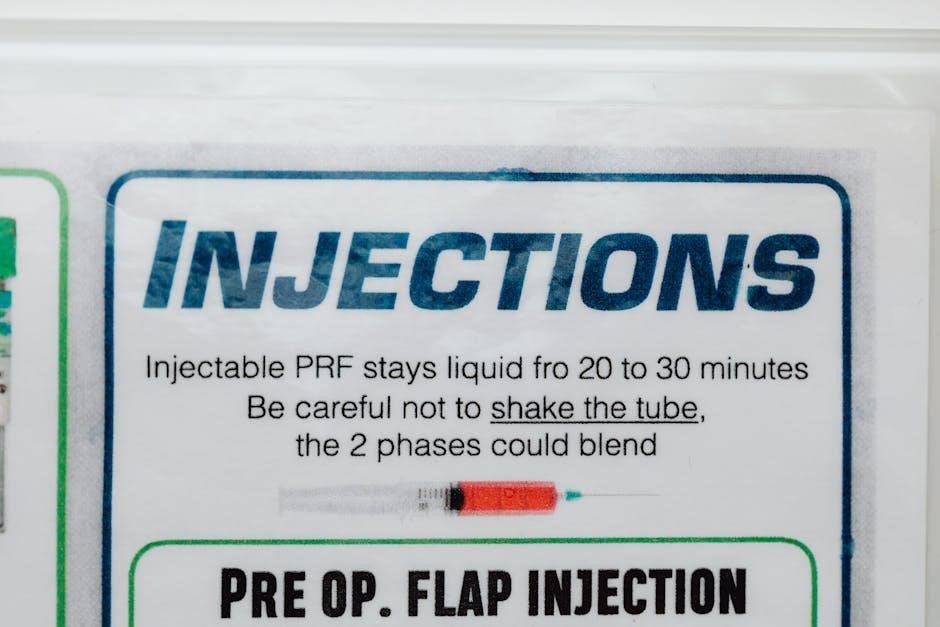ARESTIN is a periodontal treatment used to target gum disease. Following post-operative instructions ensures optimal healing and treatment effectiveness. This guide provides essential information for patients post-procedure.
1.1 Overview of ARESTIN and Its Use in Periodontal Treatment
ARESTIN is an antibiotic treatment in the form of minocycline microspheres, designed to target gum disease. It is applied directly into periodontal pockets, where it releases the antibiotic over time. This localized delivery ensures high concentrations of the medication at the infection site, promoting healing. ARESTIN is commonly used in adult periodontitis cases and is often administered alongside scaling and root planing (SRP) procedures. The microspheres slowly degrade, maintaining therapeutic levels of minocycline for extended periods. This approach minimizes systemic side effects and maximizes efficacy in treating gum disease.
1.2 Importance of Following Post-Operative Instructions
Adhering to post-operative instructions after ARESTIN treatment is crucial for optimal healing and treatment success. Non-compliance can lead to complications, such as reduced efficacy of the antibiotic or prolonged recovery. Proper care ensures the medication works effectively, minimizes discomfort, and prevents infection. Patients must avoid disrupting the treated areas to allow the microspheres to release the antibiotic as intended. Following guidelines also helps maintain oral hygiene and supports the healing process. Compliance ensures the best possible outcomes and prevents the need for additional treatments. Patients play a key role in their recovery by carefully following the recommended care routine.

Immediate Post-Treatment Care
Avoid eating or drinking for 30 minutes post-treatment to allow the medication to set. Do not touch treated areas to prevent dislodging the antibiotic microspheres. Wait 12 hours before brushing teeth to ensure proper healing begins.
2.1 No Eating or Drinking for 30 Minutes
After ARESTIN treatment, refrain from eating or drinking for 30 minutes. This allows the antibiotic microspheres to adhere properly to the treatment site. Avoiding immediate consumption ensures the medication stays in place, maximizing its effectiveness in fighting gum disease. This brief fasting period is crucial for the initial healing process and helps prevent dislodgment of the medication. By following this instruction, patients support optimal treatment outcomes and minimize the risk of complications. Adherence to this guideline is essential for the success of the procedure.
2.2 Avoiding Touching the Treated Areas
Avoid touching or probing the treated areas with fingers, tongue, or utensils. This prevents dislodging the ARESTIN microspheres, which are placed to deliver antibiotics directly to the gum pockets. Touching the areas can disrupt the medication’s placement, reducing its effectiveness. Patients should refrain from examining the treated sites to avoid unintentional interference. Keeping the areas undisturbed allows the antibiotic to work effectively, promoting proper healing and preventing infection. Adhering to this instruction ensures the treatment achieves its intended outcome and supports a smoother recovery process.
2.3 Waiting 12 Hours Before Brushing Teeth
Patients should wait 12 hours before brushing their teeth after ARESTIN treatment. This allows the antibiotic microspheres to adhere properly to the treated areas. Brushing too soon can dislodge the medication, reducing its effectiveness. When brushing resumes, use a soft-bristled toothbrush and gentle strokes to avoid irritating the gums. Avoid using abrasive toothpaste or harsh mouthwashes during the initial healing phase. Proper timing ensures the medication remains in place, providing optimal antibacterial effects and supporting the healing process. Adhering to this guideline is crucial for achieving the best treatment outcomes.

Short-Term Post-Operative Care
After ARESTIN treatment, avoid hard, crunchy, or sticky foods. Postpone flossing and interproximal cleaning for 10 days. Avoid using toothpicks or other cleaning devices during healing.
3.1 Avoiding Hard, Crunchy, or Sticky Foods
Patients should avoid consuming hard, crunchy, or sticky foods for at least one week after ARESTIN treatment. These foods can dislodge the medication or irritate the treated areas, potentially affecting the healing process. Examples of foods to avoid include nuts, carrots, apples, and caramel candies. Opting for soft, easy-to-chew foods such as yogurt, scrambled eggs, and mashed potatoes is recommended. This precaution ensures the medication remains effective and supports proper healing of the periodontal pockets.
3.2 Postponing Flossing and Interproximal Cleaning
Patients should avoid flossing or using interproximal cleaning devices for at least 10 days after ARESTIN treatment. This allows the medication to remain undisturbed in the periodontal pockets, promoting optimal healing. Premature cleaning could dislodge the antibiotic microspheres, reducing their effectiveness. However, gentle brushing with a soft toothbrush is encouraged after the initial 12-hour waiting period. Resuming normal hygiene practices too soon can irritate the treated areas and delay recovery. Adhering to this guideline helps ensure the treatment’s success and supports proper gum healing.
3.3 Avoiding the Use of Toothpicks or Other Cleaning Devices
Patients must avoid using toothpicks, floss, or any interproximal cleaning devices for at least 10 days after ARESTIN treatment. These tools can dislodge the antibiotic microspheres, reducing their effectiveness and delaying healing; The treated areas should remain undisturbed to allow the medication to work properly. This precaution ensures the antibiotic stays in place, effectively targeting the infection. Resuming such habits too soon can irritate the gums and compromise treatment success. Adhering to this guideline is crucial for optimal recovery and long-term periodontal health.

Dietary Recommendations
Proper nutrition aids healing. Avoid hard, crunchy, or sticky foods for one week. Opt for soft, easily chewable options like yogurt, eggs, and mashed vegetables to minimize discomfort and support recovery.
4.1 Foods to Avoid in the First Week
After ARESTIN treatment, it is crucial to avoid hard, crunchy, or sticky foods for the first week. These include nuts, popcorn, carrots, apples, and candies, as they can dislodge the medication or irritate the treated areas. Avoiding these foods helps protect the gums and ensures the effectiveness of the treatment. Patients should also refrain from consuming hot or spicy foods that may cause discomfort. Sticking to a soft-food diet during this period is essential for a smooth recovery and optimal healing of the gums.
4.2 Recommended Soft Foods for the Healing Period
During the healing period after ARESTIN treatment, it is important to consume soft, gentle foods that do not irritate the treated areas. Recommended options include yogurt, scrambled eggs, mashed vegetables, soft-cooked pasta, and soups. These foods are easy to chew and swallow, reducing discomfort and promoting healing. Avoid foods with sharp or hard textures, as well as overly hot or cold items, to prevent irritation. Sticking to a soft-food diet for the first week ensures the gums heal properly and minimizes the risk of complications.

Oral Hygiene Practices
After ARESTIN treatment, wait 12 hours before brushing with a soft toothbrush. Use gentle circular motions and avoid flossing for 10 days. Regular brushing and flossing are crucial for healing and preventing gum disease recurrence.
5.1 Brushing Techniques After ARESTIN Treatment
After ARESTIN treatment, wait 12 hours before brushing teeth. Use a soft-bristled toothbrush with gentle circular motions. Avoid using abrasive toothpaste or harsh brushing techniques. Focus on cleaning teeth without irritating the treated areas. Regular brushing helps maintain oral hygiene and supports healing. Proper brushing prevents plaque buildup and promotes gum health. Ensure to brush at least twice daily to maximize treatment success and prevent gum disease recurrence.
5.2 Importance of Regular Brushing and Flossing
Regular brushing and flossing are crucial for maintaining oral health after ARESTIN treatment. Brushing removes plaque and bacteria, preventing further gum disease. Flossing, when reintroduced, cleans between teeth, where brushing cannot reach. Consistency in these habits ensures the treatment’s effectiveness and supports long-term gum health. Without proper oral hygiene, treatment outcomes may be compromised, and gum disease could recur. Patients should brush twice daily and floss once a day, starting 10 days post-treatment, to promote healing and sustain a healthy smile.
5.3 Proper Flossing Techniques Post-Treatment
Proper flossing after ARESTIN treatment is essential for maintaining oral hygiene without disrupting the treated areas. Patients should wait 10 days before resuming flossing to allow the antibiotic to work effectively. When flossing, use a gentle, soft floss to avoid irritation. Guide the floss in a zigzag motion between teeth, curving it around the edges of each tooth. Avoid snapping or forcing the floss, as this could disturb the treated gum pockets. Proper technique ensures the removal of plaque without dislodging the ARESTIN microspheres, promoting optimal healing and treatment success.

Managing Discomfort or Pain
Mild sensitivity or discomfort is normal after ARESTIN treatment. Over-the-counter pain relievers can help alleviate symptoms. Avoid touching treated areas to reduce irritation and inflammation.
6.1 Over-the-Counter Pain Relief Options
Over-the-counter pain relief options, such as ibuprofen or acetaminophen, can be taken as directed to manage mild to moderate discomfort following ARESTIN treatment. Always follow the recommended dosage on the label. If you experience severe pain or discomfort that persists, consult your dentist or pharmacist for further guidance. Ensure you are not allergic to any ingredients before taking medication. These options can help alleviate symptoms during the initial healing phase, allowing you to recover comfortably while adhering to post-operative care instructions.
6.2 When to Seek Professional Help for Severe Pain
If you experience severe pain that persists despite over-the-counter pain relief, contact your dentist immediately. Severe pain may indicate complications or improper healing. Persistent discomfort lasting longer than expected should also be evaluated.
Seek professional help if pain worsens, is accompanied by swelling, or if you notice signs of infection, such as redness or discharge. Early intervention is crucial to address potential issues promptly and ensure proper recovery. Your dentist can assess the situation and provide appropriate treatment or adjustments to your care plan.

Healing Process and Expectations
Normal sensitivity or discomfort may occur after treatment. Mild swelling is expected and typically subsides within a few days. Follow instructions to ensure smooth healing and avoid complications.
7.1 Normal Sensitivity or Discomfort After Treatment
Some patients may experience mild sensitivity or discomfort following ARESTIN treatment. This is typically temporary and subsides within a few days. Over-the-counter pain relievers can help manage discomfort. If pain persists or worsens, contact your dentist promptly. It’s important to avoid touching the treated areas to prevent irritation. Adhering to post-operative instructions ensures proper healing and minimizes potential complications.
7.2 Managing Swelling or Inflammation
Swelling or inflammation at the treatment site is common after ARESTIN therapy. To manage this, apply a cold compress or ice pack to the area for 10–15 minutes at a time. Gentle pressure with an ice pack can reduce swelling. Avoid strenuous activities that may exacerbate inflammation. If swelling persists or worsens, contact your dentist for guidance. Over-the-counter anti-inflammatory medications, like ibuprofen, may be recommended to alleviate discomfort. Proper adherence to post-operative instructions helps minimize swelling and supports healing.
7.3 Expecting Discharge from the Treated Areas
A small amount of discharge from the treated areas is normal after ARESTIN therapy. This discharge typically consists of antibiotics being released from the microspheres. It may appear as a white or yellowish residue and is a sign that the medication is working. Gently rinse the mouth with warm water to remove any visible discharge. Avoid using harsh mouthwashes or forceful rinsing, as this could dislodge the microspheres. If the discharge is excessive or accompanied by severe pain, contact your dentist for evaluation to ensure proper healing and treatment efficacy.
Long-Term Care and Maintenance
Long-term care involves regular dental check-ups and maintaining good oral hygiene to prevent gum disease recurrence. Avoid habits like smoking to ensure sustained healing and treatment success.
8.1 Importance of Regular Dental Check-Ups
Regular dental check-ups are crucial after ARESTIN treatment to monitor healing progress and prevent gum disease recurrence. Dentists can assess pocket depth and ensure proper healing. Consistent visits help maintain oral health and catch potential issues early. Patients should follow their dentist’s recommended schedule for follow-up appointments to ensure long-term success of the treatment. Regular check-ups also allow for timely adjustments to oral hygiene practices, promoting a healthy and stable periodontal environment.
8.2 Maintaining Good Oral Hygiene Practices
Maintaining good oral hygiene is essential for ensuring the success of ARESTIN treatment. Brushing teeth twice daily with fluoride toothpaste and flossing once a day helps prevent plaque buildup and gum disease recurrence. Patients should avoid smoking or using tobacco products, as these habits can hinder healing and worsen gum disease. Regular rinsing with antibacterial mouthwash can also support oral health. Consistent hygiene practices help sustain the benefits of ARESTIN therapy and promote long-term periodontal stability. Proper care ensures the treatment’s effectiveness and prevents future complications.
8.3 Avoiding Habits That Can Compromise Healing
Certain habits can hinder the healing process after ARESTIN treatment. Smoking or using tobacco products should be avoided, as they can slow recovery and worsen gum disease. Patients should also refrain from consuming hard, crunchy, or sticky foods for at least one week. Avoid using toothpicks or other interproximal cleaning devices during the healing period, as they may disrupt the treated areas. Proper adherence to these guidelines ensures optimal healing and prevents complications. Consistent oral care habits and regular dental check-ups are crucial for maintaining long-term periodontal health.

ARESTIN and Periodontal Therapy
ARESTIN is a key component in periodontal therapy, delivering targeted antibiotic treatment to infected gum pockets. It works alongside scaling and root planing to combat gum disease effectively.
9.1 How ARESTIN Works in Treating Gum Disease
ARESTIN delivers minocycline microspheres directly into periodontal pockets, releasing antibiotics over time. This targeted approach fights bacteria causing gum disease, reducing pocket depth and inflammation. It is often used alongside scaling and root planing for enhanced results. The sustained release ensures prolonged antibacterial activity, promoting healing and preventing further infection. This localized treatment minimizes systemic side effects, making it an effective option for managing adult periodontitis. Patients typically experience improved gum health and reduced symptoms post-treatment. Proper post-operative care is essential to maximize its effectiveness and support the healing process. Regular dental follow-ups are recommended to monitor progress and ensure long-term oral health.
9.2 The Role of Scaling and Root Planing (SRP)
Scaling and root planing (SRP) is a deep cleaning procedure for treating gum disease. It removes plaque, tartar, and bacteria from teeth and roots, smoothing surfaces to prevent re-infection. SRP is often combined with ARESTIN to enhance treatment outcomes. By cleaning periodontal pockets, SRP creates an environment for ARESTIN to effectively deliver antibiotics. This dual approach reduces pocket depth, inflammation, and bacteria, promoting healing and improving gum health. SRP is a critical step in managing periodontitis, preparing the area for ARESTIN’s targeted antibiotic therapy. Together, they work synergistically to combat gum disease effectively. Regular follow-ups ensure sustained results and long-term oral health.
9.3 Combining ARESTIN with Other Treatments
ARESTIN is often used alongside scaling and root planing (SRP) to enhance gum disease treatment. This combination targets deep periodontal pockets, ensuring thorough cleaning and antibiotic delivery. ARESTIN complements SRP by maintaining high antibiotic levels at the infection site, reducing bacteria and inflammation. Additional treatments, such as surgical interventions or laser therapy, may be integrated based on disease severity. Combining ARESTIN with these methods promotes comprehensive healing, improving long-term gum health and preventing disease progression. Proper post-operative care is essential to maximize the effectiveness of combined therapies and achieve optimal results. Compliance with instructions ensures a successful treatment outcome.

Contraindications and Allergies
ARESTIN is contraindicated in patients allergic to minocycline or tetracyclines. Inform your dentist of any allergies before treatment to ensure safe administration.
10.1 Allergies to Minocycline or Tetracyclines
ARESTIN is contraindicated in patients with known allergies to minocycline or tetracyclines. Always inform your dentist of any allergies before treatment. If allergic, alternative treatments may be necessary. Patients should review the ingredient list with their dentist or pharmacist to confirm safety. Allergic reactions can range from mild to severe, so proper screening is essential. ARESTIN is designed for use in adult periodontitis and should only be administered by a healthcare professional. Ensuring patient safety is a priority, and allergies must be disclosed to avoid adverse reactions.
10.2 When ARESTIN Should Not Be Used
ARESTIN is not suitable for individuals with allergies to minocycline or tetracyclines, as it contains minocycline HCl. It should also be avoided during pregnancy or breastfeeding due to potential risks. Patients under 18 years old should not use ARESTIN, as safety and effectiveness in this group have not been established. Additionally, ARESTIN is not recommended for individuals with hypersensitivity to any component of the product. Your dentist will assess your medical history to determine if ARESTIN is appropriate for your treatment. Always discuss any health concerns or allergies with your dentist before proceeding with treatment.

Patient Compliance and Treatment Success
Patient compliance with post-operative instructions is crucial for optimal treatment outcomes. Adhering to guidelines ensures proper healing and maximizes the effectiveness of ARESTIN therapy in treating gum disease.
11.1 The Impact of Non-Compliance on Treatment Outcomes
Non-compliance with post-operative instructions can significantly hinder the effectiveness of ARESTIN treatment. Neglecting guidelines may lead to incomplete healing, reduced antibiotic efficacy, and potential treatment failure. Patients who do not adhere to instructions, such as avoiding certain foods or postponing brushing, risk compromising the healing process. This non-compliance can result in persistent gum disease, requiring additional treatments. Proper adherence ensures the antibiotic works effectively, promoting optimal recovery and long-term oral health outcomes. Ignoring post-operative care can undermine the success of the procedure and delay healing.
11.2 Ensuring Proper Adherence to Post-Op Instructions
Ensuring proper adherence to post-operative instructions is crucial for maximizing the success of ARESTIN treatment. Patients should strictly follow guidelines, such as avoiding hard or sticky foods for one week and waiting 12 hours before brushing teeth. Regular brushing and flossing, as directed, are essential to maintain oral hygiene without disrupting the treated areas. Compliance with these instructions helps prevent complications and ensures the antibiotic effectively targets gum disease. Patients should review the provided instructions thoroughly and ask questions if unclear to guarantee proper adherence and optimal healing outcomes.
Following ARESTIN post-operative instructions ensures proper healing and treatment success. Adherence to guidelines, such as dietary restrictions and oral hygiene practices, is key for optimal recovery.
12.1 Summary of Key Post-Operative Instructions
Key post-operative instructions for ARESTIN include avoiding eating or drinking for 30 minutes, not touching treated areas, and waiting 12 hours before brushing. Avoid hard, crunchy, or sticky foods for one week. Postpone flossing and interproximal cleaning for 10 days. Manage discomfort with over-the-counter pain relief if needed. Attend follow-up dental appointments to monitor healing. Adherence to these guidelines ensures proper healing and treatment success, minimizing complications and promoting optimal recovery.
12.2 Final Tips for a Smooth Recovery
For a smooth recovery, maintain a soft food diet, avoid smoking or alcohol, and stay hydrated. Gently brush teeth with a soft-bristled brush and avoid irritants. Attend all follow-up appointments to ensure healing progress. Manage discomfort with over-the-counter pain relievers as directed. Avoid touching treated areas to prevent irritation. Keep oral hygiene practices consistent, including twice-daily brushing and regular flossing. Adhering to these tips will promote healing, reduce complications, and support long-term treatment success.
Additional Resources
Access the ARESTIN Post-Operative Instructions PDF for detailed guidance. Visit www.arestin.com or consult your dentist for more information and support materials.
13.1 Accessing the ARESTIN Post-Op Instructions PDF
The ARESTIN Post-Operative Instructions PDF is a valuable resource for patients, providing detailed guidance on recovery and care after treatment. It can be accessed directly from the manufacturer’s official website or obtained through your dental care provider. This document outlines essential steps for a smooth recovery, including dietary advice, oral hygiene practices, and managing discomfort. Patients are encouraged to review the PDF thoroughly to ensure compliance with post-treatment recommendations, which are crucial for maximizing the effectiveness of the ARESTIN therapy.
13.2 Recommended Websites for Further Information
For additional details on ARESTIN post-operative care, visit www.arestin.com for official guidelines. The American Dental Association (ADA) website provides comprehensive resources on periodontal treatments. Patients can also explore www.perio.org for in-depth information on gum disease management. Furthermore, www.dentalcare.com offers instructional guides and videos on maintaining oral hygiene post-treatment. These platforms ensure access to reliable and up-to-date information, aiding in a smooth recovery and proper adherence to post-operative instructions.
